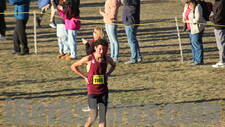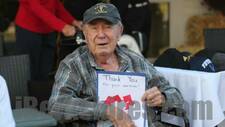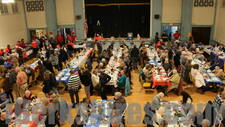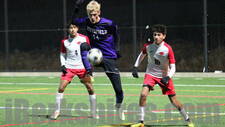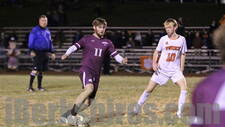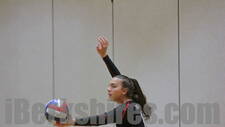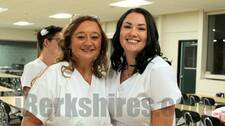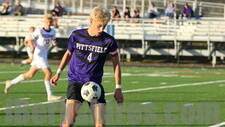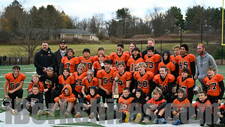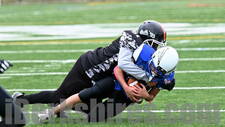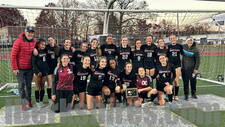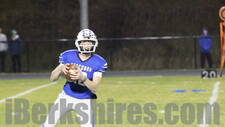Bytes from the Bean by Joe Manning 8-1-0012:00AM / Tuesday, August 01, 2000
Some people think that big money is all a community needs to grow and prosper. Unfortunately, big money without good ideas serves to enrich only those who already have big money. When you have good ideas first, big money follows them. When North Adams began to experience the decline of its industrial economy and the slow disappearance of much of its retail businesses, there were no good ideas around. It was the same old mantra: "Tear it down and build a shopping center." "Bring in more industry." "Build a highway." What North Adams got was urban renewal (parts one and two), Kmart, the L-shaped Mall, and more layoffs.
So where do good ideas come from? They often come from new people, especially if those people are artists. I know what you're saying. "Artists?" Yes, artists! When artists come to town, they bring a sense of "anything is possible." They look around with their imaginative eyes and see things in ways no one else has thought of before. Because artists are dreamers, they are immune to those negative voices: "It's not practical." "No one will support it." Where will the money come from?" "It's never been done before."
Eric Buddington, a young, bright, college educated violin player, rode into North Adams on his bike several years ago and liked what he saw. He stayed, and now he contributes to his adopted community in ways that are sometimes hard to measure. His music graces Main Street on Friday mornings at The Bean and at Acoustic Night at Papyri Books. He creates useful software technology all by himself. He volunteers his time to various agencies and causes. He works at a dot.com company located at MASS MoCA. Most of all, he brings optimism and new ideas to this community.
In a recent interview, Eric told me:
"I think the biggest thing is ideas; not just having them, but trying things, experimenting, talking to people. If I try things, I can get other people excited. Maybe not about the same things, but there's a lot of cross-pollination that can happen. You can have a group of a few dozen people who are all experimenting in a particular area; like in my case, gardening or computer software. If someone is interested in starting up a new business, that's another thing. If we have people who want to become freelance teachers, creative people, people who are thinking on their own; that's the most important thing. The things we do in our spare time are probably going to make more of a difference in the long run than the things we do professionally."
And then there is the other Eric. I am talking about Eric Rudd. He and his wife Barbara moved to North Adams ten years ago and founded the Contemporary Artists Center at the Beaver Mill. In a recent interview, he told me:
"Artists need space, they need materials, they need stimulation; and they need a place that's enriching and is supportive of their work. North Adams has all those ingredients. You can't find anyplace else like it. You can find a cheap place to live in the country, but you'll be isolated. You're not isolated here. There is this critical mass of Williams College Museum of Art, the Clark Art Institute, and MASS MoCA.
Another important part of that critical mass is our Contemporary Artists Center, because we really connect more with artists. If MASS MoCA had opened without the CAC ever existing, people wouldn't have understood it. We've had ten years of exposing the community to art not only here at the Beaver Mill, but we bring it out in the streets with various things like downtown installations. We've educated and prepared this town for MASS MoCA.
North Adams has achieved step number one, which is that MASS MoCA was built and established worldwide. Step two is this dream I have, which I think will happen. I think there's a chance to make history here. The idea of alternative spaces for art started in the late sixties and early seventies. Alternative spaces were starting up, because museums were locking out contemporary artists. Alternative spaces have dried up now. They've either become the establishment, or traditional museums have started getting more adventuresome. I think North Adams is a natural testing ground for new kinds of art. Young artists will need space that's not expensive. That kind of space still exists in North Adams.
Equally exciting are the Internet companies coming here. The great art of the future may use some stone, but it may not be "carved" stone. If you can accept that idea, then it's not a big leap to say that it's going to use multi-media apparatus. I came up to North Adams to do projects I couldn't find space for in Washington, and they were multi-media projects. In those days, MASS MoCA was going to be a Minimalist art museum, bigger than anywhere else, but traditionally the same. It was only several years ago that it developed into this multi-media complex. What's happening here is a marriage of art and technology. This is the most exciting place in the world right now. I think people here are finally beginning to understand that."
On July 21, I celebrated the four-year anniversary of my first visit to North Adams. That Sunday in 1996, my wife and I drove up to see the David Byrne exhibit at MASS MoCA, only to discover that the exhibit didn't start until the following weekend, and that MASS MoCA was still two or three years from opening. We could have gone straight home, but I was somehow captivated by the city. After several hours of walking around, I couldn't help believe that North Adams had enormous potential. Thankfully, I had the good sense to return a week later and a few hundred times since.
My visits this July have been about as quirky and exciting as they come. I owe that characterization to artists, writers, film makers, and persons in the media who have shown an interest in the city, and who have contributed to imaginative and fun-filled events on the street.
At the beginning of July, I had the pleasure of meeting Elizabeth Winthrop, an award-winning author, who is visiting the area this summer to write a children's book about North Adams. This piece of historical fiction will be about a young Italian-American girl growing up in the city during the Great Depression. The story of her life at that time will be in the form of letters she writes to President Roosevelt, and letters he writes back. Elizabeth and I talked about events that happened in the 1930's that the girl might have witnessed, where she might have lived, and what her parents might have been like. Imagine! A famous author, writing about North Adams.
On July 12th, I was in North Adams for Eric Rudd's Eagle Street Beach Party. For those who no longer live in the area and remember Eagle Street, I'm not putting you on. With the help of the city, Eric dropped tons and tons of sand on Eagle Street so that a few hundred children could play and make sand castles for three hours, while their parents looked on with cameras. More about that later.
That morning, I saw Nancy Kelly at The Bean. Nancy is a filmmaker and a North Adams native. She lives in California and has won critical acclaim for her documentaries and commercial films. She has been working on a documentary about North Adams. I met her the last time she was filming in town. She returned to film the Beach Party, among other things.
The Beach Party was scheduled to begin at four o'clock, so I walked over there with my camera about 2:30 to scout around for some interesting shots. In the store windows, there were some downtown art installations by out-of-town artists. The exhibition is sponsored by the Contemporary Artists Center. All the art is inspired by the artists' impressions of North Adams. One window was graced with paintings of various landmarks like Jack's Hot Dogs, Norm's Barbershop, and The Corner Store sign on River Street (my favorite). Another had large and colorful interpretations of doodles that were solicited from residents by the artist. Imagine! Artists inspired by North Adams.
Of course, Nancy Kelly was already on Eagle Street with her crew when I got there. She filmed and interviewed Norm at the barbershop and Laura, the lady with Benji the dog. It turned out that every time I saw something interesting, Nancy saw it first. So, I just let them set up the scene; and when they were finished, I took some pictures. I joked with her, "This is great. I get a famous filmmaker to set up the shot, and then I just jump in and take the picture." Imagine! A famous filmmaker doing a movie about North Adams.
On July 19th, I went to the library to look up some information in the city directories. As I approached the desk, I saw two people talking to Sherry. I overheard one of them say, "We're from CNN." A few seconds later, they headed upstairs.
Me: Did they say CNN?
Sherry: Yes. They're doing a story about North Adams, and they're looking for a place to interview Mayor Barrett.
Me: I've got to get them interested in my book. Maybe I can get on CNN, too.
Sherry: I know. That's why I grabbed a copy of "Steeples" and put it on the counter.
Several minutes later, one of the CNN folks came back down, and I tried to show her the book. She glanced at it and said nothing, then left. When she returned with a camera crew, I asked one of the library employees to go upstairs and tell them about me. I said, "I'm afraid I've got self-promotion written in bold letters on my forehead. Maybe you have more credibility." It didn't work. They just replied, "The spot is going to be only seven minutes, and we haven't got time to fit anything else in." Imagine! CNN in North Adams.
At four o'clock, I took fifteen senior citizens from Philadelphia on a seventy-five minute walking tour of downtown North Adams. The owner of the tour company had called me up several weeks before, because she was planning a tour of MASS MoCA. She said, "I came up last year to MASS MoCA and picked up your book and found the city so interesting, I wanted to be able to have a tour this year." The seniors were very excited about the things I showed them. I talked about the urban renewal on the south side and showed them Main Street, Holden Street, and Eagle Street. There were many questions and insightful comments. One person said Eagle Street reminded her of New Orleans. Imagine! Tourists wanting to see the real North Adams.
Back to the beach. The Eagle Street Beach Party was a blast. It was a perfect afternoon and evening: sunny, clear blue skies, dry air. A huge crowd was entertained by the energetic music of Dr. Isosceles. The sand trucks came around three-thirty. Eric Rudd and a few volunteers (including Nancy Kelly for a brief time) spread the sand around with shovels. Cops stood at both ends of the street and waved off traffic. Kids, sometimes with their parents' help, built castles or dug holes to crawl into; and in one case made an alligator with its mouth open. Eric walked around with a garden hose and sprayed water into plastic pools and little brightly colored buckets. Molly's Bakery sold tons of fried dough and whoopie pies. Jo Jo and Laura sat and watched with Benji in front of Moderne Studios.
At five o'clock, thirty or forty people were lined up to view the latest exhibit at the new Flatiron Gallery (FIG). An hour later, the award for the best sand sculpture was announced. It was the alligator, designed by A.J. Bona and his father Keith. When it was all over, the band gathered up their sound equipment, while the trucks returned to pick up the sand. I went and got a sandwich and came back, sat on the steps in front of 34 SKIDOO, and watched. There was still a crowd at the Flatiron. Several of the cops tried to show off by attempting to ride their bikes on the sand. Mostly, people just hung around, looked at the art installations, talked, and enjoyed the atmosphere and the opportunity to stand out in the middle of the street.
Thanks to an artist with an imagination, people were given a chance to have fun downtown at little or no cost, to get together with their friends, to view new and challenging art, and to celebrate a beautiful and unique street steeped in history and blessed with tremendous potential.
Again, Eric Rudd:
"A while ago, I did this 3,000 pound cube sculpture across the street from the mill. The Transcript did a photo essay about it. My friend Peter May goes to the barber shop to get his haircut, and the barber has no idea that Peter knows me. The barber says, 'Did you see that pile of junk by the Beaver Mill?' Peter says, 'It's not junk, it's art. It's a sculpture.' They start talking about it. Peter asks him, 'Do you ever get customers that want those crazy haircuts?' So they wind up discussing whether or not those kinds of haircuts are a form of art. Peter says, 'Did you ever think there would be a day when I would come into a barbershop in North Adams; and instead of talking about politics or sports, we're talking about the aesthetics of art?' "
Some people think that big money is all a community needs to grow and prosper. Unfortunately, big money without good ideas serves to enrich only those who already have big money. When you have good ideas first, big money follows them. When North Adams beg
Visit Joe's website at: www.sevensteeples.com.
Email Joe at: manningfamily@rcn.com
|


